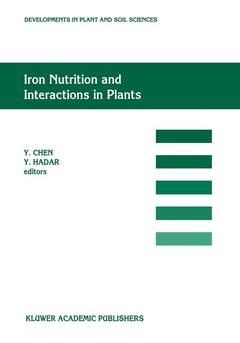Description
Iron Nutrition and Interactions in Plants, Softcover reprint of the original 1st ed. 1991
“Proceedings of the Fifth International Symposium on Iron Nutrition and Interactions in Plants”, 11–17 June 1989, Jerusalem, Israel, 1989
Developments in Plant and Soil Sciences Series, Vol. 43
Coordinators: Chen Y., Hadar Y.
Language: English
Subject for Iron Nutrition and Interactions in Plants:
Keywords
Ornithin; Symbiose; Transport; Tree; Vine; ion uptake; metabolism; nitrogen; roots
Prix indicatif 316,49 €
Disponible chez l'éditeur (délai d'approvisionnement : 15 jours).
Add to cart
Publication date: 10-2012
380 p. · 17.8x25.4 cm · Broché
380 p. · 17.8x25.4 cm · Broché
Many agricultural crops worldwide, especially in semi-arid climates, suffer from iron deficiencies. Among plants sensitive to iron deficiency are apples, avocado, bananas, barley, beans, citrus, cotton, grapes, peanuts, pecans, potatoes, sorghum, soybeans, and numerous ornamental plants. Deficiencies are usually recognized by chlorotic, in new leaves and are typically found among sensitive crops grown in calcareous or yellowed, interveinal areas soils which cover over 30% of the earth's land surface. Iron deficiency may lead, in extreme cases, to complete crop failure. In intensive agriculture on calcareous soils, iron often becomes a major limiting nutrient for optimal crop production, thus, correction of iron deficiency is required. Various chemicals and practices are available. They are, however, costly and do not always result in a complete remedy of the deficiency. Crucial questions relative to the cost-benefit equation such as the recovery rate of plants and the long-term fertilizing effect have not yet been resolved. The complexity of iron nutrition problems requires an understanding of the chemistry of iron oxides in soils, of the chemistry of both natural and synthetic chelates, of rhizosphere microbiology and biochemistry, and of the physiological involvement of the plant in iron uptake and transport.
Section 1: Chemistry of iron in soil and nutrient solutions.- Solubility and dissolution of iron oxides.- Iron oxide solubilization by organic matter and its effect on iron availability.- Manure and peat based iron-organo complexes. I. Characterization and enrichment.- Manure and peat based iron-organo complexes. II. Transport in soils.- Distribution of soluble iron and zinc in leachates of municipal wastes.- Reaction of FeEDDTA and FeEDDHA applied to calcareous soils.- Stability of chelates in nutrient solutions for drip irrigation.- Free metal activity and total metal concentrations as indices of micronutrient availability to barley (Hordeum vulgare (L.) ‘Klages’).- Section 2: Physiological and genetic aspects of iron nutrition.- Recent advances in breeding for improving iron utilization by plants.- Photochemical mobilization of ferritin iron.- Ferric chelate reduction by suspension culture cells and roots of soybean: A kinetic comparison.- Factors affecting cation-anion uptake balance and iron acquisition in peanut plants grown on calcareous soils.- Physiological plant age-dependent biochemical indicators and physiological parameters of iron nutrition.- A genetically related response to iron deficiency stress in muskmelon.- Variability of sunflower inbred lines to iron deficiency stress.- Effects of soil temperature on root and shoot growth traits and iron deficiency chlorosis in sorghum genotypes grown on a low iron calcareous soil.- Contact with ballotini (glass spheres) stimulates exudation of iron reducing and iron chelating substances from barley roots.- Investigations on iron uptake and reduction by excised roots of different grapevine rootstocks and a V. vinifera cultivar.- Characterization of the tolerance to iron chlorosis in different peach rootstocks grown in nutrient solution. I. Effect of bicarbonate and phosphate.- Characterization of the tolerance to iron chlorosis in different peach rootstocks grown in nutrient solution. II. Iron stress response mechanisms.- Section 3: Phytosiderophores in iron nutrition.- The role of phytosiderophores in acquisition of iron and other micronutrients in graminaceous species: An ecological approach.- Enhancement of ferric-mugineic acid uptake by iron deficient barley roots in the presence of excess free mugineic acid in the medium.- Why are young rice plants highly susceptible to iron deficiency?.- Comparative evaluation of iron solubilizing substances (phytosiderophores) released by oats and corn: Iron-efficient and iron-inefficient plants.- Iron-efficient and iron-inefficient oats and corn respond differently to iron-deficiency stress.- Mobilization of iron by phytosiderophores as affected by other micronutrients.- Section 4: Microbial-plant interaction in the rhizosphere and their role in iron nutrition.- Mechanisms of iron acquisition from siderophores by microorganisms and plants.- Recent advances in uptake and storage of iron in fungi.- Iron uptake and metabolism in the rhizobia/legume symbioses.- A high-affinity iron transport system of Rhizobium meliloti may be required for efficient nitrogen fixation in planta.- Responses of nitrogen-fixing and nitrate-supplied alfafa (Medicago sativa L.) to iron chelates in an alkaline hydroponic medium.- The role of active Bradyrhizobium japonicum in iron stress response of soybeans.- Siderophores of Pseudomonas putida as an iron source for dicot and monocot plants.- Development of a detection system for ferric pseudobactin using monoclonal antibodies.- Pyoverdin production by the plant growth beneficial Pseudomonas strain 7NSK2: Ecological significance in soil.- Effect of pH, L-ornithine and L-proline on the hydroxamate siderophore production by Hymenoscyphus ericae, a typical ericoid mycorrhizal fungus.- The requirement of chrysobactin dependent iron transport for virulence incited by Erwinia chrysanthemi on Saintpaulia ionantha.- Section 5: Correction of iron deficiency.- Correcting iron deficiencies in annual and perennial plants: Present technologies and future prospects.- Rational approaches to control of iron deficiency other than plant breeding and choice of resistant cultivars.- Iron deficiency in mango trees: I. New approaches to fertilization.- Iron deficiency in mango trees: II. Iron uptake mechanisms.- Correction of lime-induced chlorosis in container-grown citrus trees by peat and iron sulfate application to small soil volumes.- Simultaneous application of peanut rhizobium inoculants and an iron chelate (FeEDDHA) mixed in the inoculation tank.- Iron-index in horticultural crops.- Section 6: Symposium summary and future research.- Symposium summary and future research areas.
© 2024 LAVOISIER S.A.S.

